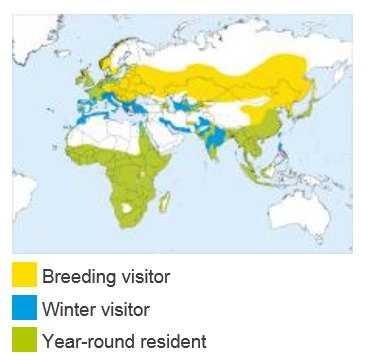Order: Pelecaniformes Family: Ardeidae Conservation Status: Least Concern
Synonyms: Common Heron, European Heron, European Blue Heron
Description:
The Grey Heron is a large bird, standing up to one metre in height, 84 to 102 cm in length with a wingspan of 155 to 175 cm and weighing between 1 and 2 kg. Adult birds have a white head and neck, the neck being streaked bluish-black at the front. A broad black supercilium extends from the eye to a slender black crest. The wings and body are ashy-grey above, whilst underparts are off-white, with some black on the flanks. Scapular feathers and the feathers at the base of the neck are elongated. The bill is pinkish-yellow, the iris is yellow and the very long legs are yellow-brown. In breeding adults the bill appears more orange whilst the legs become more pinkish. There is no major sexual dimorphism, although females do have shorter head plumes than the male.
Juvenile birds are generally duller in appearance than adults, having a grey head and neck and small, dark grey crest. Juvenile birds also lack the dark supercilium and have darker legs.
During flight there is distinct contrast between the black flight feathers and the grey back and wing coverts.
Call and Vocalisation:
The main call of the Grey Heron is a loud croaking “fraaank”. At breeding colonies a variety of other guttural and raucous noises can be heard. A loud, harsh “schaah” is used by the male in driving other birds from the vicinity of the nest whilst a soft “gogogo” is used to express anxiety when predators, or humans, are near the colony. Chicks utter loud chattering or ticking noises.
Grey Heron call
Grey Heron alarm call
Grey Heron juveniles call
Range and Distribution:
The Grey Heron is native throughout temperate Europe and Asia and also parts of Africa. It is resident throughout much of its range although some populations from the more northern parts of Europe do migrate southwards to Central Europe and sub-Saharan Africa in autumn.
Four subspecies are recognised:
ssp. cinerea (Europe, Africa, India and Sri Lanka)
ssp. jouyi (Japan, China, Indochina, Malayan Peninsular, Sumatra and Java)
ssp. firasa (Madagascar)
ssp. monicae (Mauritania and surrounding islands)
Habitat:
The Grey Heron is a bird of wetland areas and can be seen around lakes, rivers, ponds, streams, marshes, mangroves and on the sea coast. The body of water needs to be either shallow enough, or have a shelving margin in which it can wade and hunt whilst also being close to tall trees where they roost and nest.
Diet:
Grey Herons feeds mostly on fish, amphibians and small mammals which they catch after either standing stationary for hours beside or in the water or stalking their prey through the shallows. They have also been observed to catch and kill juvenile birds such as ducklings or rails, as well as scavenge the catch of other herons.
The Grey Heron’s hunting technique is to stand motionless in the shallows, or at the side of the water, waiting for prey to come within striking distance. Alternatively, it moves slowly and stealthily through the water with its body less upright than when at rest and its neck curved in an “S” shape. It is able to straighten its neck and strike with its bill extremely quickly. It will eat small fish whole, head first. Larger prey is carried to the waters’ edge where it is beaten against the ground or stabbed by the bill. The main periods for hunting occur between dawn and dusk and an adult grey heron typically needs to consume between 350 and 500 gm of food per day.
Breeding:
Grey Herons breed between February and June in colonies known as “heronries”. Nests are usually built high in trees close to a source of water for feeding. The nest, which starts as a small platform of sticks lined with small twigs, roots and dead grasses, expands into a bulky structure as more material is added. Nesting material is usually collected by the male whilst the female constructs the nest. Unless they are destroyed nests are reused year on year. A clutch typically contains three to five matt bluish-green eggs. The eggs are incubated by both parents for about 25 days. After hatching both parents feed the chicks. Juvenile birds fledge at seven or eight weeks old. Juveniles who survive their first winter typically live for about five years. Typically only one brood occurs each year, although on rare occasions two broods have been recorded. Within each clutch there is intense sibling rivalry and dominant chicks may kill, and even eat, weaker ones in order to secure food supply.
During courtship the male will call from the chosen nesting site. When a female arrives both birds she will raise her crest and both will undertake a pairing ritual. During the stretching ceremony each bird extends its neck vertically before bringing it backwards and downwards with the bill remaining vertical, whilst simultaneously flexing its legs, before returning to their normal stance. There is also the snapping ceremony where the neck is extended forward, the head is lowered to the level of the feet and the mandibles are vigorously snapped together. This may be repeated twenty to forty times. When the pairing is settled each bird will preen the other birds plumage. The male Grey Heron will then offer the female a stick which she will incorporate into the nest. After this acceptance by the female the male will further preen her and copulation will take place. Grey Herons are not monogamous and pairings only last one breeding session.
Behaviour:
The Grey Heron has a slow flight, with its long neck retracted into an S-shape which is characteristic of herons and bitterns. It flies with slow wing-beats and glides for short distances. They often perch in trees, but also spend much time on the ground near water, striding about or standing still for long periods with an upright stance, often on a single leg.
Conservation Status:
The Grey Heron is classified as Least Concern on the IUCN Red List. Despite this status, within their range, Grey Herons are vulnerable to the loss of specific breeding grounds such as mangroves. In some parts of the world Grey Herons are hunted as food or killed as pests on fish farms where they are competitors for game fish. They are also affected by pollution, pesticides and habitat destruction.
The Grey Heron is not currently threatened and is increasing its range. Consequently there are no specific conservation actions targeted at this common species.

